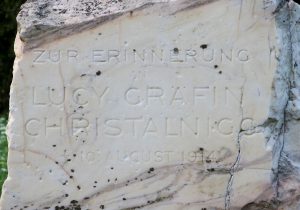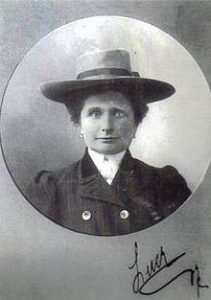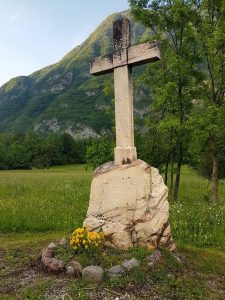Het eerste slachtoffer aan de Isonzo
Hoewel de oorlog aan het Isonzofront pas losbarst in het voorjaar 1915, valt het eerste oorlogsslachtoffer in dit grensgebied tussen Oostenrijk-Hongarije en Italië al tien maanden eerder. Deze gebeurtenis is slechts hele kleine voetnoot in de geschiedenis van deze streek, maar is daarom niet minder bijzonder. Het slachtoffer is een dame van Oostenrijkse adel en de omstandigheden zijn verdacht te noemen.
 Wie uit noordelijke richting door de Juliaanse Alpen naar het zuiden rijdt, volgt de weg die voor een groot deel langs de Isonzo. De Isonzo die door de Slovenen Soča wordt genoemd. Tussen Bovec en Kobarid staat een klein, wit monument langs de kant van de weg. Het valt niet heel erg op en menigeen rijdt er met een vaart voorbij, in de waan dat het om een gedenkteken voor een verkeersslachtoffer gaat. Op zich niet vreemd, want de weg is, zeker in de zomermaanden, erg in trek bij motortoeristen en nodigt zeker uit om het gas even goed open te trekken. Maar wie het witte monument beter bekijkt ontdekt dat het jaartal 1914 op de sokkel staat gebeiteld. En dan word je toch nieuwsgierig waarom dat gedenkteken daar staat.
Wie uit noordelijke richting door de Juliaanse Alpen naar het zuiden rijdt, volgt de weg die voor een groot deel langs de Isonzo. De Isonzo die door de Slovenen Soča wordt genoemd. Tussen Bovec en Kobarid staat een klein, wit monument langs de kant van de weg. Het valt niet heel erg op en menigeen rijdt er met een vaart voorbij, in de waan dat het om een gedenkteken voor een verkeersslachtoffer gaat. Op zich niet vreemd, want de weg is, zeker in de zomermaanden, erg in trek bij motortoeristen en nodigt zeker uit om het gas even goed open te trekken. Maar wie het witte monument beter bekijkt ontdekt dat het jaartal 1914 op de sokkel staat gebeiteld. En dan word je toch nieuwsgierig waarom dat gedenkteken daar staat.
In augustus 1914 zijn veel jonge Sloveense mannen gemobiliseerd en nemen deel in het leger van Oostenrijk-Hongarije. Ze zijn vertrokken naar Galicië of naar Servië. Toch is de oorlog niet heel ver weg. De eerste gewonden zijn inmiddels al teruggekeerd naar huis en een enkele familie heeft al het verschrikkelijke bericht gekregen dat hun dierbare zoon of jonge echtgenoot niet terug zal keren van de slagvelden.
In de kleine dorpjes rondom de Isonzo werken de achtergebleven mannen aan het binnenhalen van de oogst. Naast het werk op het land wordt een aantal van hen ook ingezet voor het bewaken van de grens met Italië. De grenswachters die deze taak normaal gesproken uitvoeren hebben ook het bevel gekregen om naar naar het front te vertrekken.
De nieuwe taak is een niet te onderschatten klus voor de landbouwers. Het gonst van de geruchten dat er smokkelaars actief zijn die goud en wapens smokkelen van Frankrijk naar Rusland en Servië en een van deze smokkelroutes zou via het (dan nog) neutrale Italië door deze streek lopen. Dat is een hele verantwoordelijkheid voor de kersverse grensbewakers en brengt ook wat nervositeit met zich mee.
 Ondertussen probeert Lucy Christalnigg, als vrijwilligster van het Rode Kruis, haar steentje bij te dragen om het leed van de gewonde soldaten te verzachten. In de omgeving van Gorizia verzamelt zij diverse goederen die zij vervolgens naar het depot in Klagenfurt brengt. Omdat Lucy getrouwd is met Graaf Oskar Christalnigg heeft zij hiertoe ook de middelen: zo heeft zij onder andere de beschikking over een auto en rijdt daar -als moderne vrouw- ook graag zelf in.
Ondertussen probeert Lucy Christalnigg, als vrijwilligster van het Rode Kruis, haar steentje bij te dragen om het leed van de gewonde soldaten te verzachten. In de omgeving van Gorizia verzamelt zij diverse goederen die zij vervolgens naar het depot in Klagenfurt brengt. Omdat Lucy getrouwd is met Graaf Oskar Christalnigg heeft zij hiertoe ook de middelen: zo heeft zij onder andere de beschikking over een auto en rijdt daar -als moderne vrouw- ook graag zelf in.
Lucy Christalnigg is als Bellegarde, een kleine adellijke familie, geboren in Graz in Oostenrijk. Lucy trouwt op 4 september 1893 met Oskar Christalnigg en ze verblijft met haar man op het familieverblijf in Klagenfurt. Ze hebben meerdere bezittingen, waaronder ook een huis in Gorizia.
De twee kinderen die worden geboren sterven al op zeer jonge leeftijd en mede hierdoor is het geen gelukkig huwelijk. De twee echtelieden volgen dan ook al vrij snel hun eigen weg.
Op 15 augustus rijdt Lucy Christalnigg van Klagenfurt, namens het Rode Kruis, naar Gorizia. Het is geen makkelijke route waarover zij haar bestemming probeert te bereiken. De weg is onverhard, kronkelt langs verschillende afgronden en wanneer de avondschemering invalt is er al snel weinig licht. Onderweg komt de gravin langs diverse controleposten van de invalgrenswachten. Dat is gelukkig geen probleem. Ze komt daar vaker langs en ze heeft toestemming om door het gebied te reizen. Daarbij wordt haar komst wordt altijd aangekondigd.
Lucy heeft al meer dan de helft van de route afgelegd, als ze bij het gehucht Srpenica aankomt, waar een controlepost van de grensbewaking is ingericht. Maar hert gaat fout. Er klinken schoten en dodelijk getroffen rijdt Lucy tegen een muur waar ze tot stilstand komt. De twee tijdelijke grenswachten hebben de schoten gelost.
De bevolking is geschokt en ook de legerleiding is geschrokken door de dood van deze adellijke dame.
Uit de archieven blijkt dat de twee mannen voor de krijgsraad worden gebracht. Waarom hebben de twee mannen geschoten? Waarom wisten zij niet van de komst van de gravin af? Waren zij mogelijk uit op het goud dat de smokkelaars langs deze route zouden vervoeren?
 Wat er precies is gebeurd is niet te achterhalen. De krijgsraad spreekt de schutters vrij, want ze is van oordeel dat de grenswachten zich aan hun richtlijnen hebben gehouden. Het bericht dat Lucy Christalnigg in aankomst was zouden zij niet hebben ontvangen, omdat zij op dat moment op patrouille waren in de omgeving. Het blijft echter onduidelijk waarom de twee de wagen niet hebben aangehouden, maar geschoten hebben. De reden die hiervoor wordt gegeven is dat de gravin is doorgereden, omdat zij in veronderstelling was dat haar komst -zoals altijd- was doorgegeven door de autoriteiten.
Wat er precies is gebeurd is niet te achterhalen. De krijgsraad spreekt de schutters vrij, want ze is van oordeel dat de grenswachten zich aan hun richtlijnen hebben gehouden. Het bericht dat Lucy Christalnigg in aankomst was zouden zij niet hebben ontvangen, omdat zij op dat moment op patrouille waren in de omgeving. Het blijft echter onduidelijk waarom de twee de wagen niet hebben aangehouden, maar geschoten hebben. De reden die hiervoor wordt gegeven is dat de gravin is doorgereden, omdat zij in veronderstelling was dat haar komst -zoals altijd- was doorgegeven door de autoriteiten.
Door dit trieste voorval is Lucy Christalnigg het eerste slachtoffer van de oorlog aan de Isonzo. In eerste instantie is zij begraven in Gorizia,maar later is het graf verplaatst naar Zollfeld in Karinthië. Op de plek des onheils heeft haar man het monument opgericht ter nagedachtenis aan haar. Het is het monument dat aan het begin van dit verhaal de aandacht trok, in de berm van de weg tussen Bovec en Kobarid.
Oscar Christalnigg overleeft de oorlog en enige jaren later trouwt hij een andere vrouw. In 1934 komt ook Oscar Christalnigg te overlijden.

